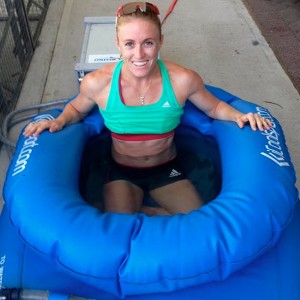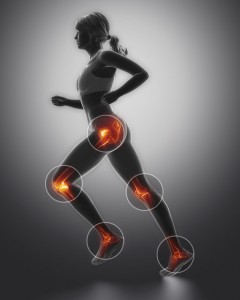What is “Recovery”?
Recovery is needed to compete at Your Best – but what really IS Recovery?
Written by Sports Physio, Britt Caling with content from AIS Recovery Specialist, Shona Halson
Recovery allows the restoration of physiological (body) and psychological (brain) processes so that you can:
- Compete or train again at a similar level
- Allow adaptations to training to occur
- Increase the quality and quantity of training
- Reduce the risk of developing overuse injuries and
- Reduce risk of overreaching (overtraining)g & symptoms
- And is therefore essential to performance!
The body needs to be physically stressed (through exercise) to improve fitness. However, the body actually improves when at rest (ie during recovery) as recovery counteracts the physical damage that occurs during exercise.
Improvements in fitness occur because of rest and recovery AFTER training.
- Competition, training, study/work and social stressors all contribute to fatigue. You need to Recover from all stressors to gain the maximum benefit to performance
Recovery strategies include:
- Hydrotherapy (water strategies)
- Rest and sleep
- Nutrition
- Warm-down and stretch
- Physio & Massage
- Compression Garments
- Psychological methods – ie. relaxation, mental imagery
Hydrotherapy options for Recovery
1.Contrast water therapy: alternating HOT/COLD WATER immersion
1 minute in spa, 1 minute in plunge pool Repeat 5-7 times
2.Contrast Showers: 30 seconds warm to hot (comfortable temp), 30 seconds cold
Repeat 3-5 times
3.Cold Water Immersion (IceBaths/ Cryotherapy)
- Accumulate 5min total time: 5min straight if possible, or 1min in:1min out x5
- Water temp <14degrees
 Considerations for using Water Therapies for Recovery:
Considerations for using Water Therapies for Recovery:
- If Fatigued: Cold Water Immersion shown to be the best. Aim for 10-12 mins in cold
- For Muscle Soreness (Delayed Onset Muscle Soreness): Contrast water therapy shown to be the best. Aim for 15 mins in water starting and finishing on cold
- Submerging full body is important.
- Finish on cold if using hot/cold
- Pick 3-4 training sessions a week as there is a thought that too much cold water immersion may reduce normal inflammatory processes that are actually needed for tissue repair and recovery
- Do not use Cold water immersion in the 1hour prior to training/competition due to the reduction in nerve conduction velocities and possible effect on motor skills
- Precautions
- DO NOT use hot/cold therapy if you have an illness (i.e. cold or virus)
- Do NOT use hot if you have an injury, open wound or bruising
- DO NOT use if you have Diarrhoea
For more thorough planning on how to individualise the use of Water Therapies to aid your recovery, talk to our Physio’s or Exercise Physiologist for full details. Phone us for an appointment on 07 5500 6470.
The above strategies are great as an assist to training if you have access to facilities, but one of the simplest and key factors to assist your recovery can be done in your own home, and that is: ensuring you get enough rest and relaxation.
Some key points about Sleep:
Sleep is when maximal physical and psychological restoration occurs
Sleep loss may be related to the development of overreaching & overtraining and:
◦ increases the onset and/or magnitude of pain perceptions
◦ decreased focus and concentration
◦ causes difficulty in determining why errors are made
◦ causes confusion remembering instructions and facts
The Importance of Sleep
 No matter what sport you do, these above factors are not great for helping you perform and improve, therefore it is essential you get optimal sleep and relaxation for good performance and repeat performance in training.
No matter what sport you do, these above factors are not great for helping you perform and improve, therefore it is essential you get optimal sleep and relaxation for good performance and repeat performance in training.
Did you know?
Your sleep perception (how you felt you slept) is just as important as how much sleep you actually have for recovery and performance.
Just as we wash our hands to ensure we reduce our risk of picking-up bugs that can make us sick, there are some things we can do to help ensure we have good quality of sleep. These factors are about good “sleep hygiene”.
Sleep Hygiene refers to strategies to ensure you get good sleep and include:
* Maintain a regular sleep-wake cycle (i.e. going to bed and getting up at the same time of the day)
* Use napping appropriately (naps should not interfere with night-time sleep and should be less than 1hr)
* Plan fluid/food intake so you are comfortable to go to sleep and so that you don’t wake too many times at night to use the bathroom
* Do not use your bed for work or watching television
* Ensure bed is comfortable and the room temperature is appropriate (19-21°C is often recommended)
* Avoid thinking, planning or other mental activities. You will need to work out what strategies work for you to help this (ie. use a notebook to write your thoughts down before sleep)
* Avoid things which may reduce sleep:
* Caffeine
* Alcohol
Hyper-hydration: In a recent survey of AIS athletes, frequent waking to go to the bathroom was one of the major reasons for sleep disturbance and may be related to a large consumption of fluid with minimal amounts of sodium in the time between finishing training/competition and bed-time
If you are having trouble with Sleep and Relaxation, try a Consult with our Sport Psychologist Abra Garfield. Alternatively, Ruth Anderson from MiND HQ has also developed a relaxation iPhone app, designed to provide athletes with all the tools required to manage stress and tolerate anxiety to perform under pressure.
Relaxation HQ provides:
- All the information you need to understand & effectively manage stress
- CoA checklist to identity your signs of stress
- A personalised relaxation plan
- The ability to monitor your relaxation response
- Four relaxation audio tracks and information to train you in relaxation skills
For more information, click here or phone us on 07 5500 6470
Compression Clothing
 So what is all the fuss really about? What is compression clothing? and What do I use compression garments for?
So what is all the fuss really about? What is compression clothing? and What do I use compression garments for?
Compression garments are a relatively new tool for athletes and research is currently being undertaken to determine all the true benefits.
What they seem to do is help both performance and recovery by:
◦ Improving athletic performance by maintaining repeated jump performance – great for sports like AFL where repeated jumps in a game are crucial for keeping possession of the ball
◦ Reducing muscle movement and vibration and focus the direction of the muscle- excellent for distance running or activities where there is a repeated movement pattern over-and-over again in order to reduce muscle fatigue from the vibrations and reduce the metabolic cost of running
◦ Maintaining body temperature and moisture wicking – particularly useful for keeping the body warm in colder environments and helping the body during warm-up. Surprisingly, the moisture-wicking ability allows these garments to evaporate sweat and also helps keep the athlete cool in hotter environments.
◦ Assisting in the athlete’s psychological recovery from repeated bouts of exercise compared to passive recovery – obviously useful to perform well when the athlete needs to back-up in multiple games (ie. duirng Touch Footy carnivals) or for multiple events (ie. Swimming championships)
◦ Reducing the time taken for muscles to repair themselves by altering muscle metabolites and swelling produced during exercise and also reducing muscle soreness during post workout recovery following eccentric (muscle lengthening) exercise – almost every competitive sports involves eccentric muscle contractions so this suggests compression garments are excellent for helping muscles recover to a more normal state, and faster, following sport
◦ They may also be an alternative to Compression stockings worn during long flights to reduce the risk of Deep Vein Thrombosis (DVT) caused by pooling of blood in the lower legs
◦ They provide support to help keep male genitalia in place, are great under short skirts (such as womens hockey) to avoid exposing underwear and help reduce chaffe between the legs when running.
Compression garments can be worn between training sessions/games, during training, at night or during long-haul flights.
At Gold Coast Physio & Sports Health we stock BSc and 2XU compression. Both companies are Australian and produce garments of exceptional quality.

